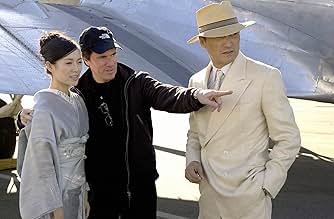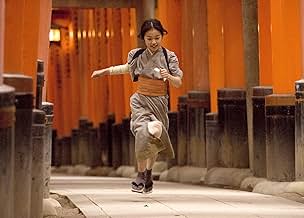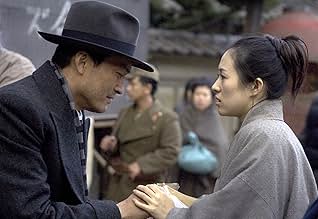The heartwarming tale of Nitta Sayuri, a young Japanese woman who transcended from her fishing-village roots and became one of Japan's most celebrated geisha.The heartwarming tale of Nitta Sayuri, a young Japanese woman who transcended from her fishing-village roots and became one of Japan's most celebrated geisha.The heartwarming tale of Nitta Sayuri, a young Japanese woman who transcended from her fishing-village roots and became one of Japan's most celebrated geisha.
- Won 3 Oscars
- 32 wins & 47 nominations total
- Director
- Writers
- All cast & crew
- Production, box office & more at IMDbPro
Storyline
Did you know
- TriviaThere was much discussion about the traditional Geisha hairstyles of the time period and the filmmakers decided to give each character a specific hairstyle that was slightly symbolic of her character. Pumpkin's hair was slightly over-exaggerated with many ornaments to indicate her character's desperation to succeed. Hatsumomo's hair when loose was wild, while her up-do was set with sections of hair dangling out to indicate her character's disregard for tradition, and her loose morals. Mameha's hair was side swept with simple buns or generally loose over one shoulder to give her a simple elegant appearance, as Mameha is supposed to be naturally beautiful. Sayuri's hair was always a simple style either in a bun, a braid or a less exaggerated style to indicate her natural beauty and less need of elaborate styles.
- GoofsWhen Hatsumomo and Pumpkin are leaving on the night of Pumpkin's debut, neither Mother nor Auntie spark flint on their backs. A Geisha would never leave her okiya without this act being performed as it was believed it brought good luck.
- Quotes
Sayuri Narration: The heart dies a slow death. Shedding each hope like leaves, until one day there are none. No hopes. Nothing remains.
- Crazy creditsNo studio logos are shown at the beginning. They however appear shortened after the end credits and are accompanied by the film's score.
- ConnectionsFeatured in The 63rd Annual Golden Globe Awards 2006 (2006)
- SoundtracksAnata No Mono Yo
Written by Takao Saeki and Kouka Sassa
Performed by Noriko Awaya
Courtesy of Columbia Music Entertainment, Inc.
Featured review
Going into the film, I had worries with all the slamming critics have given, even though I didn't read all of them in details. However, I'm happy to say it turns out to be one of more satisfying movie experiences of the year.
First I echo the sentiment that the film is simply technically perfect. The retro-mood it created had me immensed in the world of geisha from beginning to the end. It's very 1930 Shanghai like. The music score isn't as haunting as the one in CTHD, but it is still masterfully composed and fits in the background very well. It's worth seeing for the big screen experience alone. The story also never dragged, as each of the three parts flowed nicely. I normally don't like voice-over, but here it really held the movie together and helped to move the story along.
As for the accents, the problem has definitely been exaggerated. I was expecting a lot of unpleasant broken English to be spoken, but they all sounded fine to good, not just from the most fluent Michelle Yeoh, but Ken Watanabe, Youki Kudoh (who plays Pumpkin) and other supporting casts. Gong Li had a few awkward lines at the beginning, and Ziyi had more and is the one who had to try the hardest, but both pulled off admirably and didn't hurt their performances in the process.
Talking about performances, I think almost all of them did well. It's much more of an ensemble piece, and I was especially impressed by the young Sayuri and Ken Watanabe.
The main problem I have is with character development. It is a Cinderella story at heart, but the good and evil are too clear-cut and lack dimension. I also want to see more ups and downs for the competition between Ziyi and Gong Li. Gong did all she could, but the script didn't allow her to be a worthy opponent. Except for some verbal back-and-forth between the two and a few dirty tricks from Gong, there was no reason to believe why she was the most famous geisha in Japan before Ziyi arrived.
In addition, the Mother character is over-the-top and didn't fit the emotional aspect the film quite well, although she did provide some comical moments. The big dance scene had excellent buildup, but the execution of the dance felt flat. It lasted only about 30 seconds, while doubling that and making it more mesmerizing would have made the whole middle act more effective.
These flaws didn't overshadow the fact that what was put on screen worked for me. Will I be willing to watch it again with friends? In a heartbeat. Will I recommend it to others? Definitely. With that in mind, I give the film an A-.
First I echo the sentiment that the film is simply technically perfect. The retro-mood it created had me immensed in the world of geisha from beginning to the end. It's very 1930 Shanghai like. The music score isn't as haunting as the one in CTHD, but it is still masterfully composed and fits in the background very well. It's worth seeing for the big screen experience alone. The story also never dragged, as each of the three parts flowed nicely. I normally don't like voice-over, but here it really held the movie together and helped to move the story along.
As for the accents, the problem has definitely been exaggerated. I was expecting a lot of unpleasant broken English to be spoken, but they all sounded fine to good, not just from the most fluent Michelle Yeoh, but Ken Watanabe, Youki Kudoh (who plays Pumpkin) and other supporting casts. Gong Li had a few awkward lines at the beginning, and Ziyi had more and is the one who had to try the hardest, but both pulled off admirably and didn't hurt their performances in the process.
Talking about performances, I think almost all of them did well. It's much more of an ensemble piece, and I was especially impressed by the young Sayuri and Ken Watanabe.
The main problem I have is with character development. It is a Cinderella story at heart, but the good and evil are too clear-cut and lack dimension. I also want to see more ups and downs for the competition between Ziyi and Gong Li. Gong did all she could, but the script didn't allow her to be a worthy opponent. Except for some verbal back-and-forth between the two and a few dirty tricks from Gong, there was no reason to believe why she was the most famous geisha in Japan before Ziyi arrived.
In addition, the Mother character is over-the-top and didn't fit the emotional aspect the film quite well, although she did provide some comical moments. The big dance scene had excellent buildup, but the execution of the dance felt flat. It lasted only about 30 seconds, while doubling that and making it more mesmerizing would have made the whole middle act more effective.
These flaws didn't overshadow the fact that what was put on screen worked for me. Will I be willing to watch it again with friends? In a heartbeat. Will I recommend it to others? Definitely. With that in mind, I give the film an A-.
Details
- Release date
- Country of origin
- Official site
- Languages
- Also known as
- Hồi Ức Của Một Geisha
- Filming locations
- California State Railroad Museum - 111 I Street, Sacramento, California, USA(interiors: railroad station)
- Production companies
- See more company credits at IMDbPro
Box office
- Budget
- $85,000,000 (estimated)
- Gross US & Canada
- $57,490,508
- Opening weekend US & Canada
- $682,504
- Dec 11, 2005
- Gross worldwide
- $162,242,962
- Runtime2 hours 25 minutes
- Color
- Sound mix
- Aspect ratio
- 2.39 : 1
Contribute to this page
Suggest an edit or add missing content







































